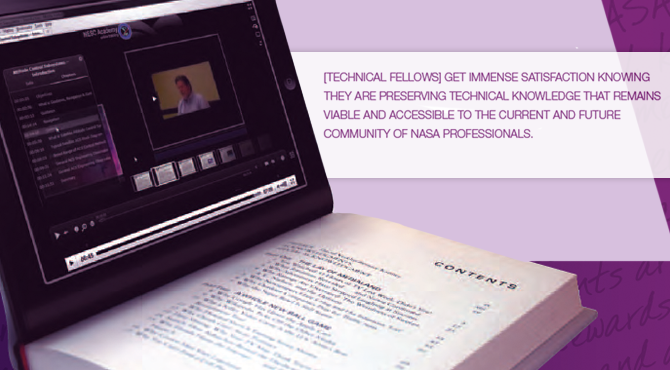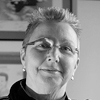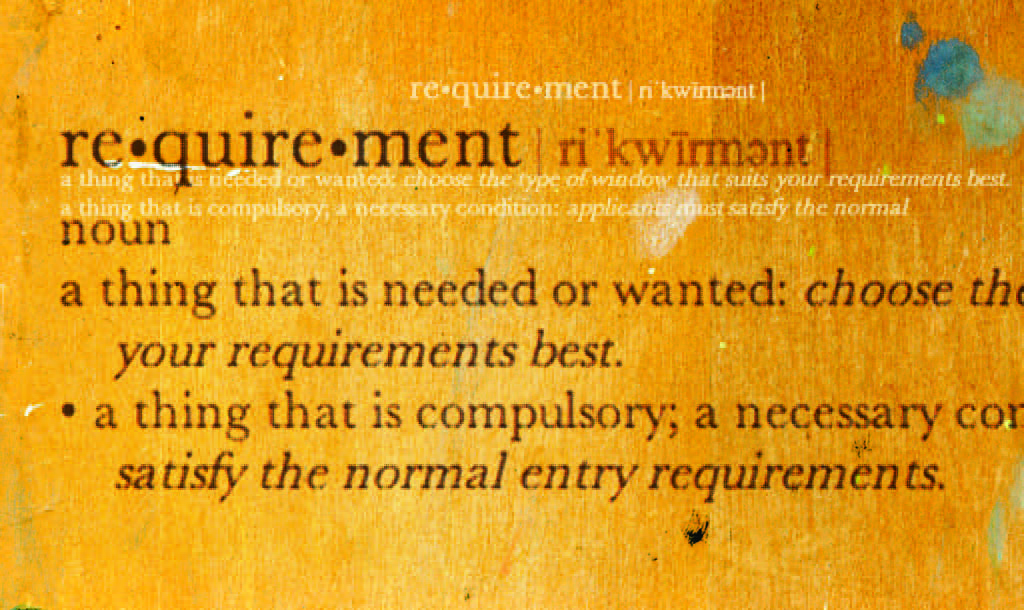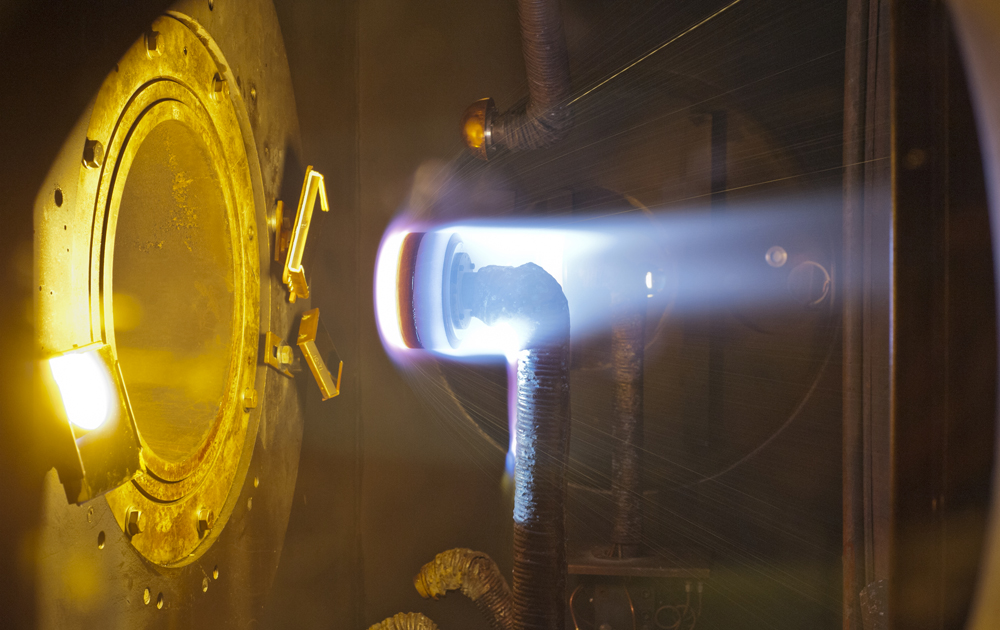
By Patricia Pahlavani
The NASA Engineering and Safety Center (NESC) recently implemented the new NESC Academy (nescacademy.nasa.gov), an innovative online academy documenting hundreds of lessons learned from senior engineers and subject-matter experts working some of the most complex technical challenges at NASA. Since 2005, the NESC Academy has captured, preserved, and shared the knowledge and experiences of senior NASA engineers and scientists that are invaluable to the work of the next generation of NASA technical professionals. Beginning in 2009, NASA technical fellows and their colleagues, who served as subject-matter experts, delivered courses in a two- to three-day classroom environment. After nine such instructor-led courses, the NESC leadership decided the courses were too costly and required excessive preparation from the experts, whose primary NESC mission is to evaluate critical, high-risk NASA projects.
In 2010, the NESC began reviewing and benchmarking modern capture and delivery mechanisms with the goal of reinventing the Academy while reducing costs and lessening the demands on experts’ time. The NESC’s systems and communications team was given the challenge. The team used the Khan Academy, started by Salman Khan, as a model.1 The Khan Academy began as short, online courses in science, technology, engineering, and math to tutor remote family members. It has since grown to more than 3,500 micro-lectures, with over 190 million views. The NESC team benchmarked products that could facilitate the effective capture and delivery of the NESC online lessons. The team also collaborated with the NASA Safety Center, which uses Mediasite to capture and stream content to the Internet.
Because NESC’s experts are spread across the country, capturing content from remote locations, including a user’s desktop, was a challenge. Initially, a “training toolbox” was physically sent to the expert’s location. It contained all the software and hardware necessary to record a lesson. A simple PowerPoint plug-in and new server software (Camtasia Relay), which enables lessons capture directly from the user’s desktop and transfers the data remotely to the NESC servers, replaced the toolbox. This technology enables remote video capture without requiring travel, complicated data file transfers, and extensive upfront preparation.
— Albert Einstein
Once the NESC’s servers receive the video lessons, they are processed using an eleven-step method that includes editing, course-material insertion, export-control review, and closed captioning. To track the processing, the NESC Academy team uses a tool called TrackVia, an online, cloud-based tool configured to monitor progression. It provides workflow, tracking, dashboards, and processing support for all video production.
In 2011, the NESC began collaborating with the NASA Engineering Network (NEN), also within the Office of the Chief Engineer, to provide live, online webcasts. Using Academy hardware, these webcasts give NASA technical fellows and their colleagues the ability to present material remotely to large audiences in real time. Webcasting allows the presenter, moderator, and producer to reside in different locations. Live webcasts are recorded for later viewing. All upcoming and recorded webcasts are available from the NESC Academy web site at nescacademy.nasa.gov/#features=2. To date, the NESC has captured more than 200 videos, with 123 published, that document work across thirteen technical disciplines online. The new online NESC Academy officially launched on September 8, 2012, and has had more than three thousand viewings to date.
The NASA technical fellows are passionate about sharing technical knowledge. They and their discipline teams solve some of the most varied and difficult technical problems at NASA. This experience gives them a clear picture of where their discipline excels and, more importantly, where critical investments are required to advance NASA’s technical capability. As stewards of their disciplines, they use their experience to develop and document a state-of-the-discipline assessment, identifying knowledge gaps and proposing strategies to fill them. Conducting reviews and assessments daily, they look for opportunities to address these shortcomings and capture knowledge and experience that might otherwise be lost or forgotten.
At a technical interchange meeting sponsored by the aerosciences technical discipline team, for example, the NESC recognized that there was a wealth of NASA knowledge and experience in the aerosciences discipline of significant benefit to both the commercial crew partners developing the next spacecraft servicing low-Earth orbit and the NASA team tasked with the evaluation and selection of these concepts. The meeting was designed as a series of case studies and briefings outlining flight-development projects, including the shuttle orbiter, HyperX/X-43A, X-38, Ares, Ares I-X, and Orion. Presentations focused on the aerosciences philosophy, strategies, techniques, experiences, and lessons learned in predicting aerodynamic performance, constructing aerodynamic databases, predicting flight environments, and managing uncertainty. Participants included the NESC, Langley Research Center, Johnson Space Center, Ames Research Center, Marshall Space Flight Center, commercial crew partners, the NASA Commercial Crew and Cargo Program Office, and other industry and agency guests.
All the case studies and lectures were recorded. The content is now being placed on the NESC Academy web site.
Since the technical fellows’ technical discipline teams consist of experts from all NASA centers, along with other government agencies, industry, and academia, members live and work all across the country. Each team assembles in annual face-to-face meetings to share experiences, strategize discipline advancement, and network. In 2011, at a joint meeting of the aerosciences, flight mechanics, and guidance, navigation, and controls teams, a member with extensive experience in the development of Gemini, Apollo, and the shuttle orbiter gave a presentation entitled “Lessons Learned on Previous Manned Spaceflight Programs That Seem to Have Been Forgotten.” While that original presentation was not recorded, an encore presentation to the broader NESC a few months later was captured on video and is available on the NESC Academy site. This is a good example of how engineering knowledge and experience is captured by the technical fellows, in near real time, and preserved by the Academy.
[Technical fellows] get immense satisfaction knowing they are preserving technical knowledge that remains viable and accessible to the current and future community of NASA professionals.
The NASA technical fellow community has enthusiastically embraced the new, user-friendly methodology. They get immense satisfaction knowing they are preserving technical knowledge that remains viable and accessible to the current and future community of NASA professionals. Technical fellows and their discipline teams determine the courses to capture and make available on their NESC Academy catalog. The disciplines and other webcast presenters also suggest future topics.
Classroom courses previously videotaped are now being converted to the new NESC Academy online format, the results streamlined and improved by applying additional editing and cleanup. The content is now more accessible to users than in the past, as there are no prerequisite reading requirements. Of course, in an exclusively online format, the hands-on aspects of viewing hardware and models in the classroom and the back-and-forth dialogue and networking with colleagues and senior professionals are lost. To compensate, all webcasts offer a question-and-answer period at the end of each session. The subject-matter experts answer questions and address issues that were either not addressed or needed clarification. All questions and answers are retained as part of the webcast and are available on the NESC Academy web site and to the communities of practice on the NEN.
An exciting new development is the rebroadcasting of a webcast within university settings, followed by the subject-matter expert connecting to the classroom via Skype to address students’ questions live. The NESC team may explore more possibilities of this kind to increase the level of interaction. Currently, the NEN communities of practice serve as the avenue for interacting with other technical professionals and providing feedback on webcasts and other content so that continuous improvement becomes a part of the process.
Amadou Hampâté Bâ, an African ethnologist, famously stated, “… when an elder dies, it’s a library burning.” With the new approach to capturing and delivering content, the NESC is attempting to preserve NASA’s “technical library.” In short, there is more to acquiring knowledge than what is in textbooks; knowledge also develops from lived experience, and veteran NASA experts possess decades of knowledge and experience that is invaluable to the aerospace community.
While the NESC Academy has changed, the core mission remains the same: to help senior NASA scientists and research engineers pass on critical technical expertise and problem-resolution skills to the younger workforce to support continuing and future mission success.
Related Links
- NESC Academy Online
About the Author










